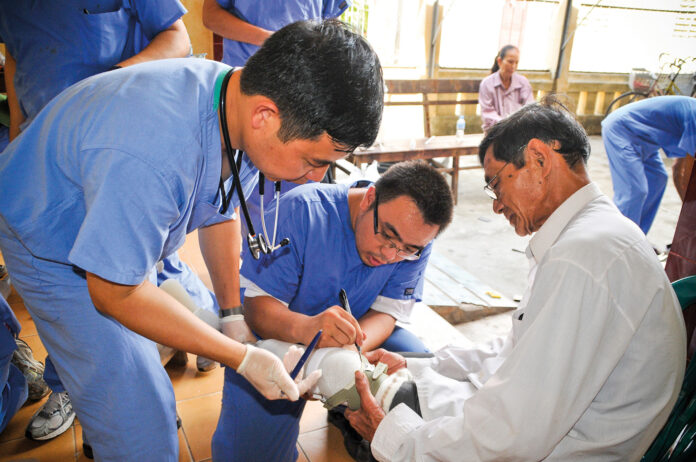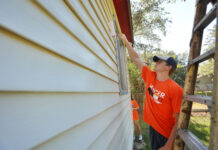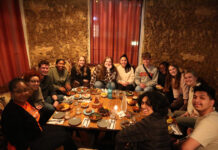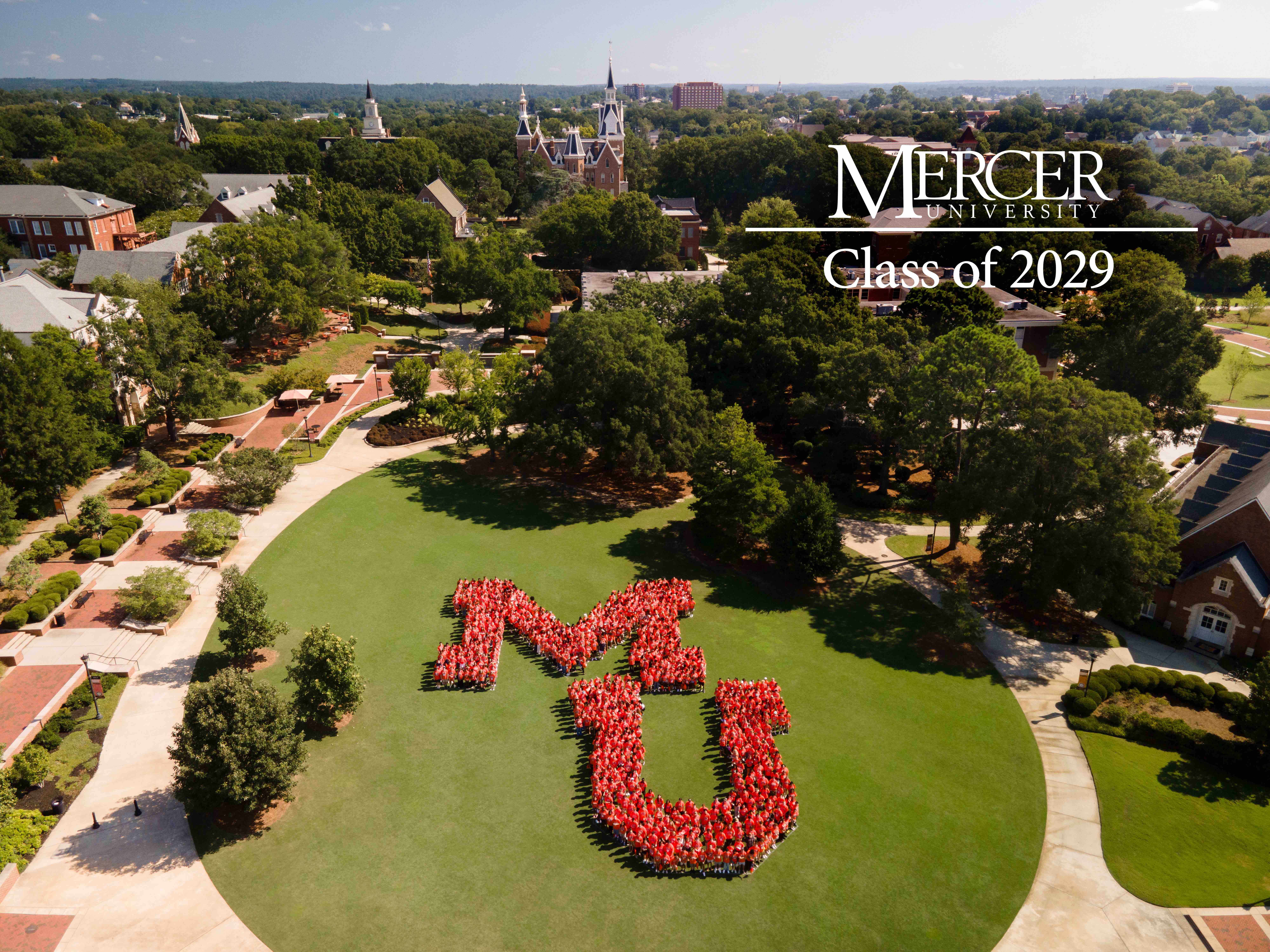Dr. Craig McMahan keeps a video on his cellphone. The footage begins with an image of a middle-aged Vietnamese farmer, his arms slung over a set of rickety crutches, struggling back and forth across a room.

His baseball hat is pulled slightly down, leaving much of his face in shadow. His black pants are cropped around the knee, where both his legs end. As he moves around the room under a large Vietnamese flag, he is surrounded by Mercer students — all of them identifiable by their sky-blue scrubs — who sit on child-size red chairs leaning over amputee patients of their own.
The video briefly pauses. The next frame starts an entirely new scenario. In it, the man, now outfitted with two new prosthetic legs, walks toward the camera as he releases his crutches to the ground. With his arms free, he begins to dance and a huge smile spreads across his face.
“In Vietnam, there are 100,000 amputees like this man,” explains Dr. McMahan, director of Mercer On Mission. “We fit him with two prosthetic legs over four hours, and this is the difference.”
An idea takes root
Dr. McMahan has scores of stories just like this one. He’s been collecting them since he began Mercer On Mission’s prosthetics program in Vietnam in 2009 with Dr. Ha Van Vo, Distinguished University Professor of Biomedical Engineering and a refugee from southern Vietnam.
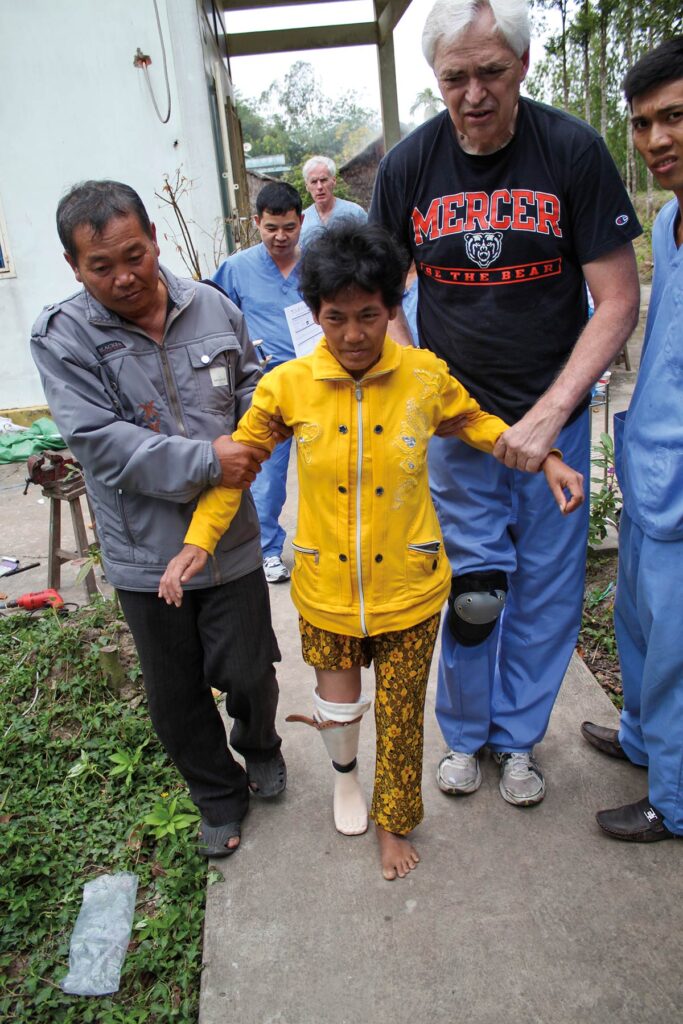
In a country where 3.2 million mines remain unexploded, and thousands of Vietnamese are crippled by mines, diabetes, and motorcycle accidents on an annual basis, the need for prosthetics is enormous.
And the program, says Dr. McMahan, began as a direct result of Dr. Vo’s own experiences in post-war Vietnam. “He wanted to find a way to give back.”
When Dr. Vo and Dr. McMahan made their first trip to Vietnam 13 years ago, they traveled with a group of 10 students and a large bag of prosthetic parts designed and fabricated in Mercer labs.
After arriving in Phụng Hiệp, a rural area in the Mekong Delta region of the country, Dr. McMahan, Dr. Vo and a group of Mercer students boarded a slim banana boat that took them through backwater channels and into the jungle, where they set up a tent and got to work.
That year, the group fit about 38 amputees. It may not have been a large number, but it was a meaningful one.
“I remember coming home one night, in the pitch black, on one of the little finger-length boats, and thinking about the day,” recalls Dr. McMahan. In particular, he thought about a man who, after receiving his prosthetic leg, told the group that they had given him his life back. “I thought, whatever it is we’re doing here, this is Mercer On Mission.”
The following year, Mercer On Mission fit 52 amputees. The program continued to grow from there. Now, when Dr. McMahan, Dr. Vo and students from Mercer make their annual three-week trip across Vietnam, they can fit upward of 1,000 amputees and address another 3,000 orthopedic cases, too.
“When we show up at 8 in the morning, there are already masses of people waiting in line for the clinic,” says Dr. McMahan. “We will stay until midnight to make sure every single one of them gets care.”
For Mercer President William D. Underwood, who in 2006 charged Dr. McMahan with launching Mercer On Mission, that was always the point.
“The goal of our research faculty is more than securing external funding for their projects,” he says. “The goal has always been to make a difference in a lot of lives, no matter their situation.”
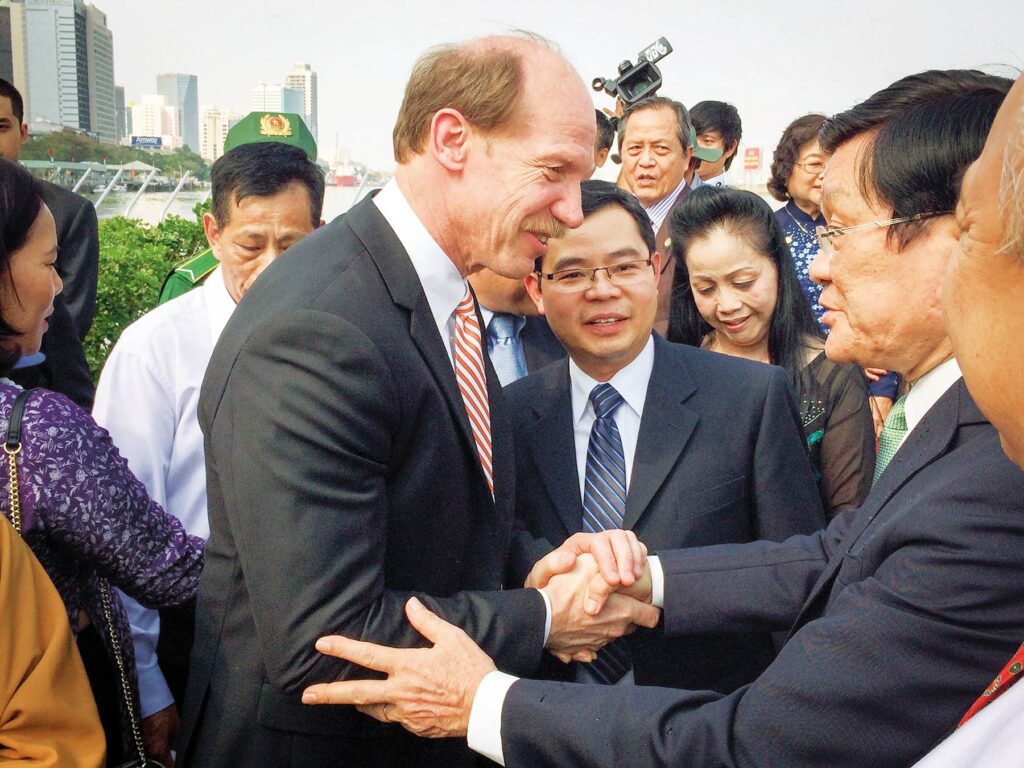
The leg
Another way Mercer On Mission has made an impact in Vietnam is by reinventing the leg prosthetic itself. Starting in 2007, Mercer On Mission began using a unique prosthetic leg designed by Dr. Vo on the Macon campus. Made from molded polypropylene, a lighter and more durable plastic that’s inexpensive to produce, each leg features an adjustable hose clamp that allows a customizable fit.
The cost to produce such an advanced prosthetic in the United States, says Dr. McMahan, could reach as much as $15,000. But in Vietnam, where Dr. Vo and his team have trained manufacturers to build the device, they can now make one for under $250 and produce them at a large scale.
Creating the prosthetics, however, is just part of the process. Learning to fit them is equally important.
“There’s a great deal of science to how you fit these legs,” explains Dr. McMahan. That’s why Mercer students take two courses on campus before traveling to Vietnam.
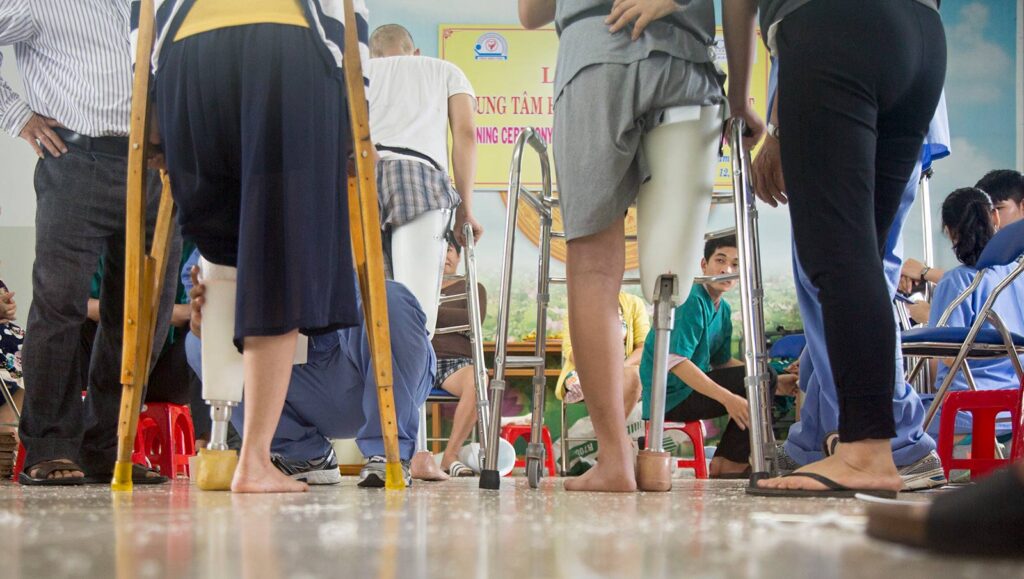
The training has paid off. Now, over a decade after Mercer On Mission began, the program runs four clinics across the country and has fit over 15% of the amputees across Vietnam. Annual assessments indicate an extraordinarily high success rate for all amputees since the program began in 2009.
But even as the program has grown, the work still feels very personal to Dr. McMahan.
“We hear people in Vietnam say that the war is over, and they don’t want to live in the past. And when a person receives a prosthetic leg, it allows them to move forward. It’s an act of kindness. And that really is the original vision.”
That commitment has not gone unnoticed. Last spring, the Macon-based Phil J. and Alice S. Sheridan Foundation gave $10 million to endow the Sheridan Center at Mercer and support the work of Mercer On Mission with a special focus on the prosthetics program.
A lasting impact
Another photo Dr. McMahan keeps on his phone is from a few years ago. In it, he sits beside Vietnamese Prime Minister Nguyen Xuan Phuc. After sharing how much Mercer enjoyed their work in Vietnam, he asked the prime minister how they could better serve the country and its people. “I asked him if there is anything we should improve,” recalls Dr. McMahan. “And he said make it bigger, citing Mercer On Mission as the most effective NGO (non-governmental organization) operating in Vietnam.”
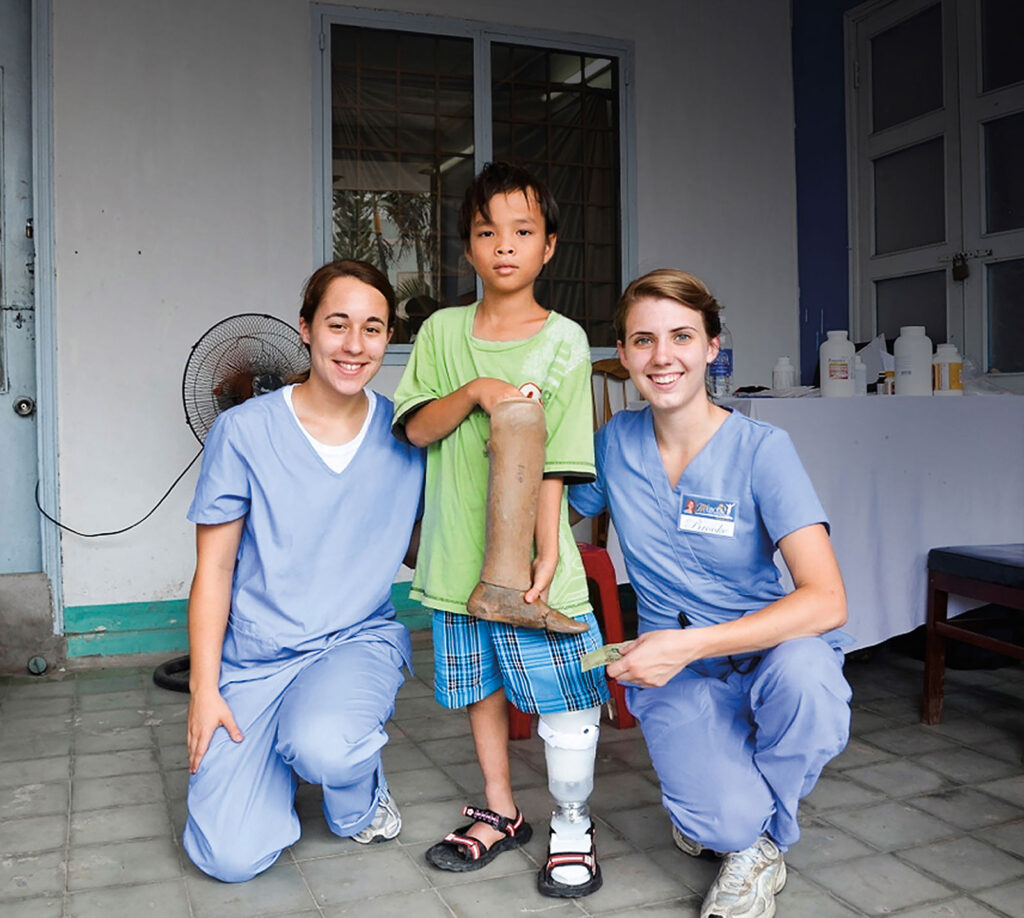
Life-changing experiences
Mercer On Mission combines study abroad, applied research and service-learning to provide life-changing experiences for students through academic instruction and cultural immersion. From its establishment in 2007 with initial programs in Brazil, Guatemala and Kenya involving seven faculty and 38 students, Mercer On Mission has since completed 134 projects at 45 international sites. More than 2,500 students and faculty have participated in Mercer On Mission, with the number growing annually.
Mercer On Mission student-faculty teams have helped African and Caribbean villages develop sustainable sources and methods for delivering clean water, greatly reduced mercury pollution by artisanal gold miners in Latin America, and mentored Rwandan entrepreneurs — many of them widows and orphans of the 1994 genocide — to improve their business plans, skills and practices. The program has produced multiple patents and received international recognition, including the Gold Award and top prize of $200,000 in the 2020 Artisanal Mining Grand Challenge.
Countries where Mercer has deployed teams
(As of 2022)
- Armenia
- Belize
- Brazil
- Cambodia
- China
- Columbia
- Costa Rica
- Dominica
- Dominican Republic
- Ecuador
- Ethiopia
- Ghana
- Greece
- Guatemala
- Guyana
- Haiti
- Honduras
- India
- Indonesia
- Jordan
- Kenya
- Kosovo
- Liberia
- Madagascar
- Malawi
- Mexico
- Moldova
- Mongolia
- Mozambique
- Nepal
- Palestine
- Peru
- Republic of Georgia
- Romania
- Rwanda
- Senegal
- South Africa
- South Korea
- Tanzania
- Thailand
- Trinidad
- Uganda
- Ukraine
- Vietnam
- Zimbabwe

